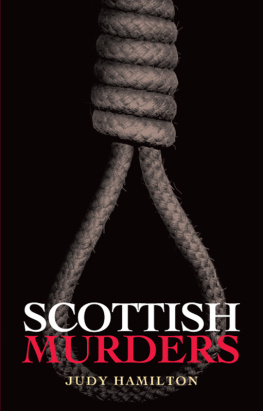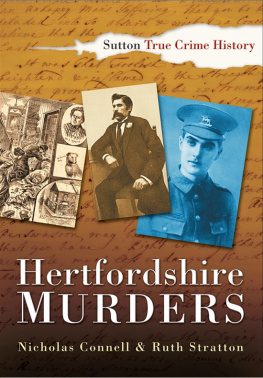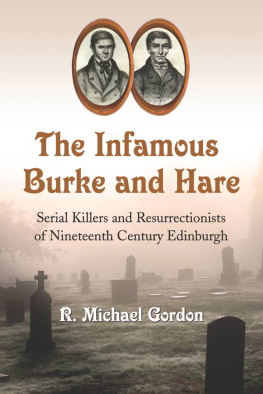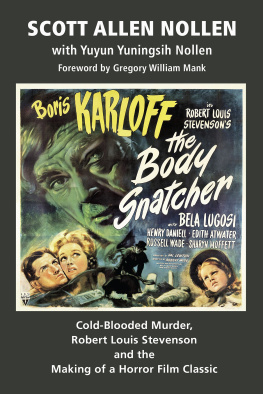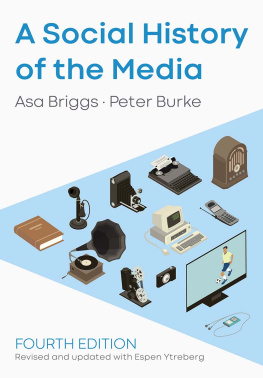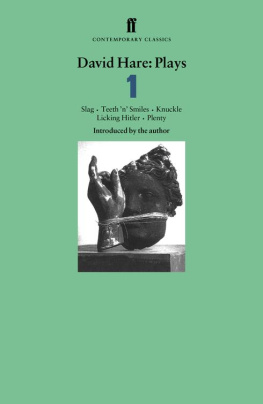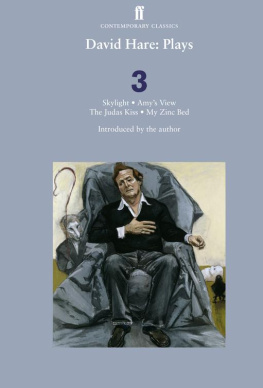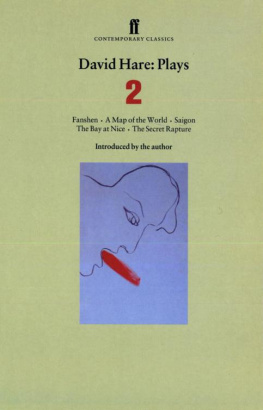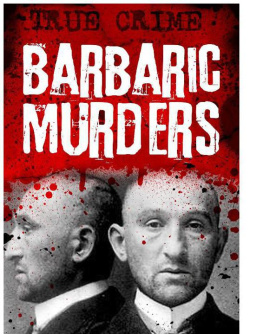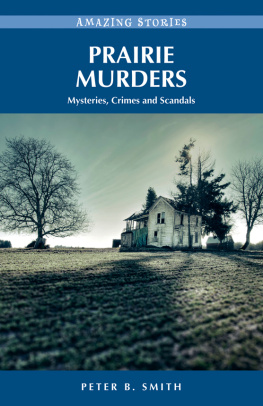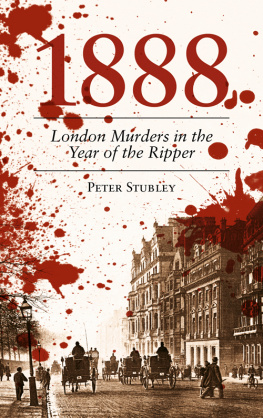Judy Hamilton - Scottish Murders. From Burke and Hare to Peter Tobin
Here you can read online Judy Hamilton - Scottish Murders. From Burke and Hare to Peter Tobin full text of the book (entire story) in english for free. Download pdf and epub, get meaning, cover and reviews about this ebook. year: 2011, publisher: Perseus Books Group;Waverley Books, genre: Non-fiction. Description of the work, (preface) as well as reviews are available. Best literature library LitArk.com created for fans of good reading and offers a wide selection of genres:
Romance novel
Science fiction
Adventure
Detective
Science
History
Home and family
Prose
Art
Politics
Computer
Non-fiction
Religion
Business
Children
Humor
Choose a favorite category and find really read worthwhile books. Enjoy immersion in the world of imagination, feel the emotions of the characters or learn something new for yourself, make an fascinating discovery.
- Book:Scottish Murders. From Burke and Hare to Peter Tobin
- Author:
- Publisher:Perseus Books Group;Waverley Books
- Genre:
- Year:2011
- Rating:4 / 5
- Favourites:Add to favourites
- Your mark:
- 80
- 1
- 2
- 3
- 4
- 5
Scottish Murders. From Burke and Hare to Peter Tobin: summary, description and annotation
We offer to read an annotation, description, summary or preface (depends on what the author of the book "Scottish Murders. From Burke and Hare to Peter Tobin" wrote himself). If you haven't found the necessary information about the book — write in the comments, we will try to find it.
Scottish Murders. From Burke and Hare to Peter Tobin — read online for free the complete book (whole text) full work
Below is the text of the book, divided by pages. System saving the place of the last page read, allows you to conveniently read the book "Scottish Murders. From Burke and Hare to Peter Tobin" online for free, without having to search again every time where you left off. Put a bookmark, and you can go to the page where you finished reading at any time.
Font size:
Interval:
Bookmark:

Scotland has a bloodstained past. Over the centuries, countless Scots have met a brutal end in battle or in full-scale war. Many hundreds of others have died at the hands of persecutors; so-called witches were hounded from their homes, tortured and put to the death on the most bizarre of charges. The Covenanters were persecuted in the name of the king on account of their religious beliefs. At times the full force of the law itself was almost indistinguishable from murder the executioner dealt with many poor souls whose crimes would merit no more than a relatively light sentence in modern times. Housebreaking, horse-stealing and petty theft often carried the death penalty. Scotland was indeed a land of rough justice in centuries gone by.
There is always an outcry when crime statistics are published, but in spite of this, it cannot be denied that we live in safer times nowadays. We have a police force working with the benefit of sophisticated technology to hunt down the few perpetrators of serious, violent crime. We have the law on our side to protect us from persecution. Things are not perfect, but they are very much better than they were.
It is impossible to imagine a time when the streets of Scotland or any other country will be crime-free. Human beings are not robots. As much as human beings are capable of good, they are capable of evil.
There is no one answer to the question: What makes one person take anothers life? Many murders are committed in the heat of the moment, in outbursts of uncontrollable fury or moments of crazed fear. They are not the result of endless planning and cold, slow, premeditation. When killings like this happen, the murderer may feel the need to kill for no more than a few moments. When the deed is done, the remorse is immediate. These are the killings that make some people say that everyone is capable of murder, given the right (or rather wrong) circumstances.
Some killings are acts of insanity, but the line between psychosis and psychopathic or sociopathic disorder has to be carefully drawn. The psychotic killer suffers from an illness that distorts his mind only for as long as he is ill. The psychotic killer can be treated. The psychotic killer is, in fact, a rare phenomenon. A person suffering from psychosis is much more likely to take his or her own life than the life of another. The behaviour of a psychopath, however, cannot be treated in the same way. A psychopath has a personality disorder and if he feels the need to kill once, he is likely to kill again. It is unlikely that his behaviour will change significantly, in spite of the best efforts of psychiatrists. Other killings are acts of retribution or revenge, often linked to other crimes. Gang warfare and drug-related crime have both left our streets spattered with the blood of their dead. Finally, murder is used as a means to an end. The end may be money, sexual gratication, power or freedom. The act of killing may be the end in itself.
But if the nature of murder remains horribly consistent, the nature of detection is changing. Recent advancements in the new technology of DNA analysis have not only improved the chances of linking a killer to the crime, but have also opened up the possibility that cold cases can be re-investigated with a good chance of success.
DNA is the genetic code in every cell in your body, from skin to bone. Every individual (except identical twins) has a DNA profile that is unique. Killers leave behind traces of blood, semen, saliva and hair. When a suspect is arrested the police have the right to take a DNA sample, usually via a mouth swab. The sample is compared with the DNA collected at the murder scene and archived in the Scottish DNA Database, which is held at Dundee.
DNA has figured successfully in a number of recent Scottish murder trials, such as the 1991 murder of Vicky Hamilton by Peter Tobin (see page 182). And in 2009 DNA evidence led directly to the conviction of Marek Harcar for the rape and murder of Moira Jones in Glasgows Queens Park.
Many older unsolved Scottish murder cases are now being re-opened. Clothes stained with semen or blood, or hairs collected at the scene, are being re-examined. In some cases all the men in a local population are being asked to voluntarily come forward for DNA sampling, so that they can be eliminated from the enquiry. Sadly DNA profiling is sometimes unable to help, especially if the original samples have become degraded over time, or if they have been contaminated with DNA from other people. But despite this DNA profiling will undoubtedly assist in the identification of criminals from the past few decades, killers who thought that they had literally got away with murder.
This book relates some of the most famous (or infamous) murders in Scotlands history. It cannot begin to tell them all. None of them is pleasant, but all of them are intriguing for different reasons. With the exception of three stories where the murders were not proven (the deaths at Ardlamont and Goatfell and the case of Madeleine Smith), the stories in this book tell of killings that were certainly premeditated. The story of Oscar Slater tells of a man who was innocent of a crime for which he was convicted, but the crime, whoever did it, had without doubt been carefully planned. The reasons for the killings in the stories that are told here vary considerably and will give the reader an idea of some of the circumstances and some of the motives that can drive a person to murder. Scotland is no exception to any other place in the world. Wherever you go, there will be someone, somewhere, who feels that death is the only answer. And in response to the actions of people like this, we will always ask: Why?
Perhaps the most appalling and grisly tale told of murder in Scotland is that of the Bean family, who held the county of Galloway in the grip of terror in the fifteenth (or sixteenth) century. (It is worth noting that there is some debate as to whether the Bean family ever really existed, and the precise dating of events has become obscured over the years). The familys catalogue of gruesome crimes continued for some twenty-five years unsolved and many others were to be wrongfully punished for crimes they did not commit before the Beans were finally brought to justice.
At the head of the clan was Sawney Bean. He came from East Lothian, a few miles from Edinburgh, the son of a hedger and ditcher. Any hopes his father might have had for his son to follow him in that profession, humble though it was, or indeed any dreams that he had for his son to make any honest livelihood at all, were swiftly dashed when Sawney ran away from home while still in his teens.
Sawney moved around for a while, finally settling in a remote part of Galloway. There, having joined up with a young woman who shared his desire to live a life free of responsibility or morality, he found himself a cave in which to dwell. Well hidden from the casual passer-by, virtually cut off at high tide, this bleak dwelling place was to suit his purposes perfectly.
Over the course of the next twenty-five years, the Bean family grew in numbers until Sawney and his wife had not only a good number of children but grandchildren as well nobody knows exactly how many. As the family lived a life in hiding, isolated from general society, it has been assumed that the grandchildren were the products of incestuous relationships.
The family lived entirely by theft, murder and cannibalism. As time passed, people in the surrounding districts grew increasingly alarmed as one story after another of disappearing people was circulated. Locals, visitors and travellers men, women and children alike all were vanishing without trace. Alarm in the district spread farther afield, and the government sent men to spy around the area and investigate the crimes. Not only were people disappearing, but sometimes their butchered remains discarded by the Beans were found washed up in the shallows around the coast.
Font size:
Interval:
Bookmark:
Similar books «Scottish Murders. From Burke and Hare to Peter Tobin»
Look at similar books to Scottish Murders. From Burke and Hare to Peter Tobin. We have selected literature similar in name and meaning in the hope of providing readers with more options to find new, interesting, not yet read works.
Discussion, reviews of the book Scottish Murders. From Burke and Hare to Peter Tobin and just readers' own opinions. Leave your comments, write what you think about the work, its meaning or the main characters. Specify what exactly you liked and what you didn't like, and why you think so.

